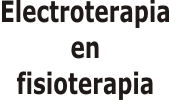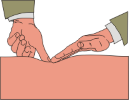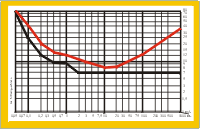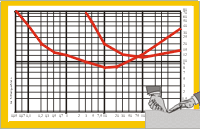 08/01/2026 10:10:15
08/01/2026 10:10:15
Peripheral paralysis treatment
Translated from Spanish in form automatic
Technique necessary to conserve as much as possible: the activity minimal muscle activity, and biochemistry in the motor endplate and accelerate regenerative processes at the point of nerve injury until the paralyzed area is reintroduced.
Introduction
It is common to see in the published literature references to doubts about the effectiveness of this treatment and find controversies regarding the technique. First, usually whenever there is controversy it involves a lot of ignorance on the subject and little practical experience.
We have a problem: we know a lot about electrotherapy for the sport but we have little mastery of electrotherapy for pathologies, especially this one, which is the most subsidiary of this treatment.
If a paralysis is treated correctly, the result is excellent (unless the prognosis responds to a complete axonopnesis); but the good response requires work, dedication in time and mastery of the technique. This has a problem: that it is not very profitable, it requires a lot of dedication and you have to study.
We must differentiate between nerve root palsy and paralysis intramedullary or anterior to the medullary reticular formation. Paralysis peripheral causes flaccid and atrophic paralysis of the area or limb affected, along with areflexia. But a paralysis prior to the root nerve preserves the reflex arc and electrical stimulation can cause spasticity or other disorders.
Muscle fiber paralyzed by injuries higher than training Medullary reticularis usually responds to electrical stimulation as normal fiber (although it will undergo progressive degeneration). The fiber muscle denervated by post-training nerve injury medullary reticular degenerates and does not respond as normal fiber, both the muscle such as the motor nerve.
Electrical stimulation of the muscles affected by spinal cord injury anterior or superior to the reticular formation, at the very least controversial, because it can produce or trigger spasticity.
Refreshing the concepts of physiological response to external
electrical stimuli, and its graphic representation, the normal and
innervated muscle fiber responds with some ease ("considered standard
or physiological") to electrostimulation, being represented in two
typical graphs: one reflecting the square impulse response (I/T) and
another impulse triangular (A/T). Let's see the typical representation
of the curves (I/T) - (A/T) normal in the following figure.
Curves I/T - A/T of normality.
This means that the average pulse time to get response easily found
between 1 and 2 ms with a quadrangular shape, and membrane
repolarization time is around 10 to 30 ms. In the upper curve, or of
(A/T), we observe on the right a very marked and fast ascent, good
pulse accommodation indicator progressive rise.
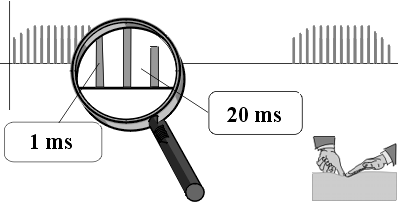
Faradic trains.
When we are faced with a peripheral denervation, these physiological circumstances or phenomena are altered in such a way that: curves move up and to the right, all the more so as the greater the degree of injury. An example of severe disturbance could be the one in the following figure.
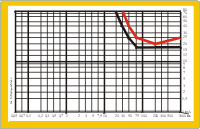
Curves I/T - A/T denervation.
We appreciate how the possible response to short pulses (a good pulse time can be a few 100 ms). More intensity is required than on the normality curve. Are both curves are very similar, that is, the triangular or (A/T) has largely lost the ability to accommodate triangular pulses (shown in the gentle climb). The membrane repolarization time can be move up to 2, 3 or 4 s. In cases of total muscle degeneration, The curves could not be drawn because there would be no response to electrical stimuli, even if they were very long and intense.
This means that normal muscle fiber stimulation (graph normality) we can apply it with trains or bursts of pulses home runs whose pulse time is 1 to 2 ms and rests of about 20 more inside the train. But since these parameters are altered in the paralysis (and / or parexia) we will be forced to regulate pulses isolated quadrangles of about 100 ms (in the case of the example) separated 2, 3 or 4 s without trains. In every circumstance, the curves we they will indicate the best values.
Therefore, we will do the treatment with isolated pulses, long and home runs whenever possible. But we we will usually encounter a problem, due to the neighborhood between healthy and denervated muscles, so that the pulses home runs will cause large contractions of healthy ones without get a response from the sick. If all were denervated, we will use quadrangular pulses.
In a treatment to contract denervated muscles it is essential get your answer, if not, the treatment will be Useless. Circumstance that fuels the controversy.
To achieve the proposed objective we will take advantage of the
phenomenon pathophysiologic loss of accommodation by fibers denervated
by triangular pulses. This means that the denervated musculature
responds almost the same to triangular pulses as to long
home runs. But healthy muscles are accommodates the triangular
long , preserving good response to home runs.
Therefore, we will apply pulses triangular long for
the denervated to work and the healthy are filtered. LONG!
How long ...? . We will see this reflected in the & nbsp;
triangle of therapeutic utility (TUT).
Utility triangle therapy
If we superimpose on the same graph the triangular or (A / T)
corresponding to the healthy and the denervated, we will observe that
intersect, so that: in short times they show their threshold more
under the healthy, but in long times the sick show it.
Therapeutic utility triangle TUT.
Therefore, if our objective is based on exceeding the response threshold in the denervated avoiding the response of the healthy, we will regulate the pulses triangular so that their time parameters and intensity coincide within the triangle formed by the vertical of 1,000 ms to the right, the healthy curve above and the curve of those denervated below.
We will try to adjust the parameters as much as possible possible left as long as we reach the desired response. Toward on the left, both muscle groups are easily mixed. Far to the right discomfort and risk of burns appear. Good judgment, the answer of the patient and mastery of the technique will allow us to decide the more correct parameters, and even different from day to day.
Webinar on the peripheral paralysis treatment
protocol.
An example of treatment
Treatment
The time and intensity appropriate to each case should adjust the professional guided by the daily examination (certainly quick and easy).
The rest time between pulses is decided according to the response to the fatigue, so if in a couple of minutes the contraction disappears (of the denervates) we increase the seconds of rest.
The application will be made with a point electrode manually jumping from motor point to motor point of the affected muscle group when notice fatigue (after several minutes). We will make several wheels or passed through the different motor points.
The session will last between 30 and 45 minutes. If it can be two sessions a day better than one.
A good treatment strategy may be self-application of the patient under proper control, but explaining well to the patient methodology until you correctly understand the parameters, answers sought and objectives. This is not so rare, since at be the normally long treatment, they end up learning what is applies to them.
Exploratory I/T - A/T curves should be performed every week or every 15 days to assess the evolution of the pathology and try to obtain a forecast based on the evolution of the curves.
Do not leave the electrodes applied for 20 minutes "and we go to another thing". It will only be useful for the first 4 or 5 minutes, during the rest up to 20 will be caused damage by the strong component galvanic current. This is the reason why apply a spot electrode treatment that moves to new motor points every 4 or 5 minutes.
It is better to apply biphasic pulses out of phase (not biphasic consecutive), which are always single-phase, although with those out of phase, only the half of them will be really usable; but they are avoided Burns. Since it is complex to avoid preventing the circumstance of strong galvanic effect, it must be reduced as much as possible to avoid galvanic aggression that alters tissues, causing more effects harmful than beneficial. Hence one of the controversies about its effectiveness.
Electrodes must be moved between various locations within days alternating to avoid galvanic aggression. Thus, although the electrodes sometimes they are not in the most correct place, playing with TUT values the motor response of the denervates is achieved.
If the prognosis is bad, the work done will be thrown away. But yes the prognosis is hopeful, the results will be good and faster than expected. Therefore it is important to know reliably about the possibilities of reinnervation.
As soon as voluntary activity is appreciated, we introduce myofeedback in the treatment protocol.
As the patient evolves, either to improve or to worsen, the triangle is changing and the current parameters must adjust to the new situation. In case of improvement, this TUT is lengthens to the left and descends, allowing more and more pulses short, less intense and closer together; until you can adjust parameters similar to normality behavior with trains of square pulses of 1 ms pulse and 20 ms rest for fiber fury.
Do you want to go back to the Electrotherapy Treatments menu?
Published in English on 01/12/2021
